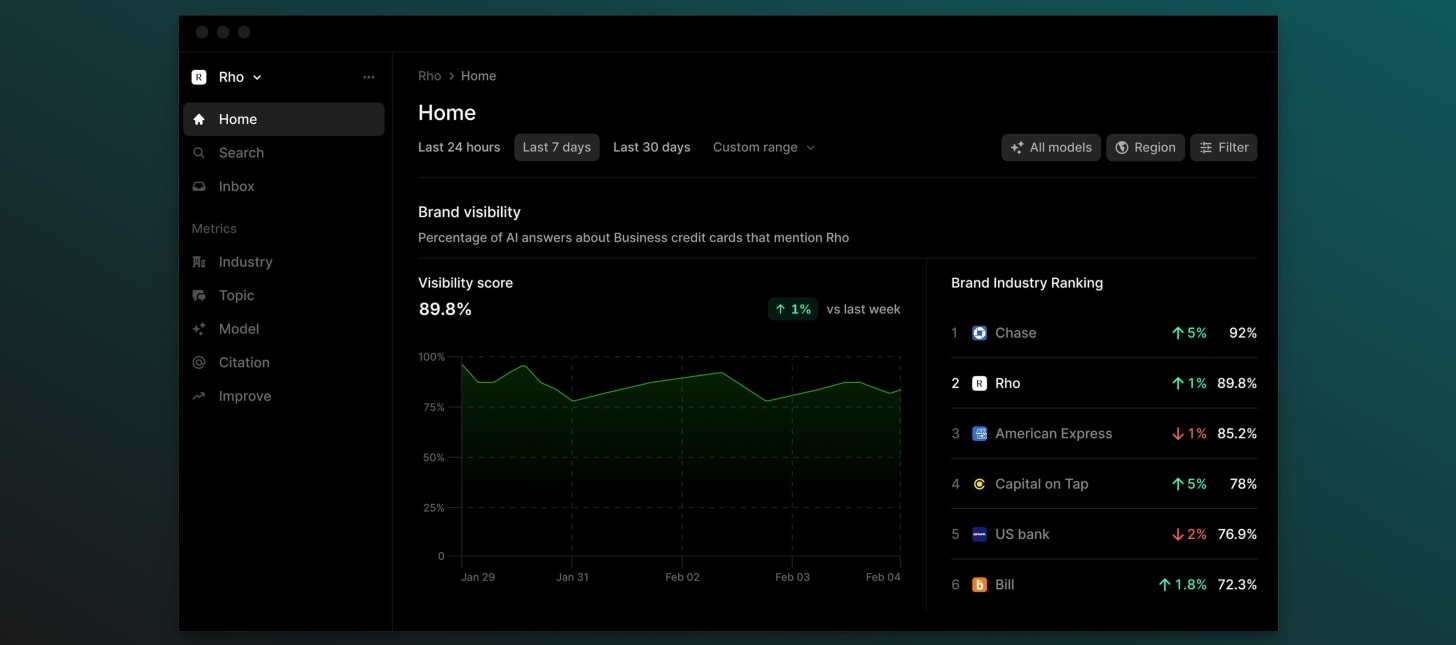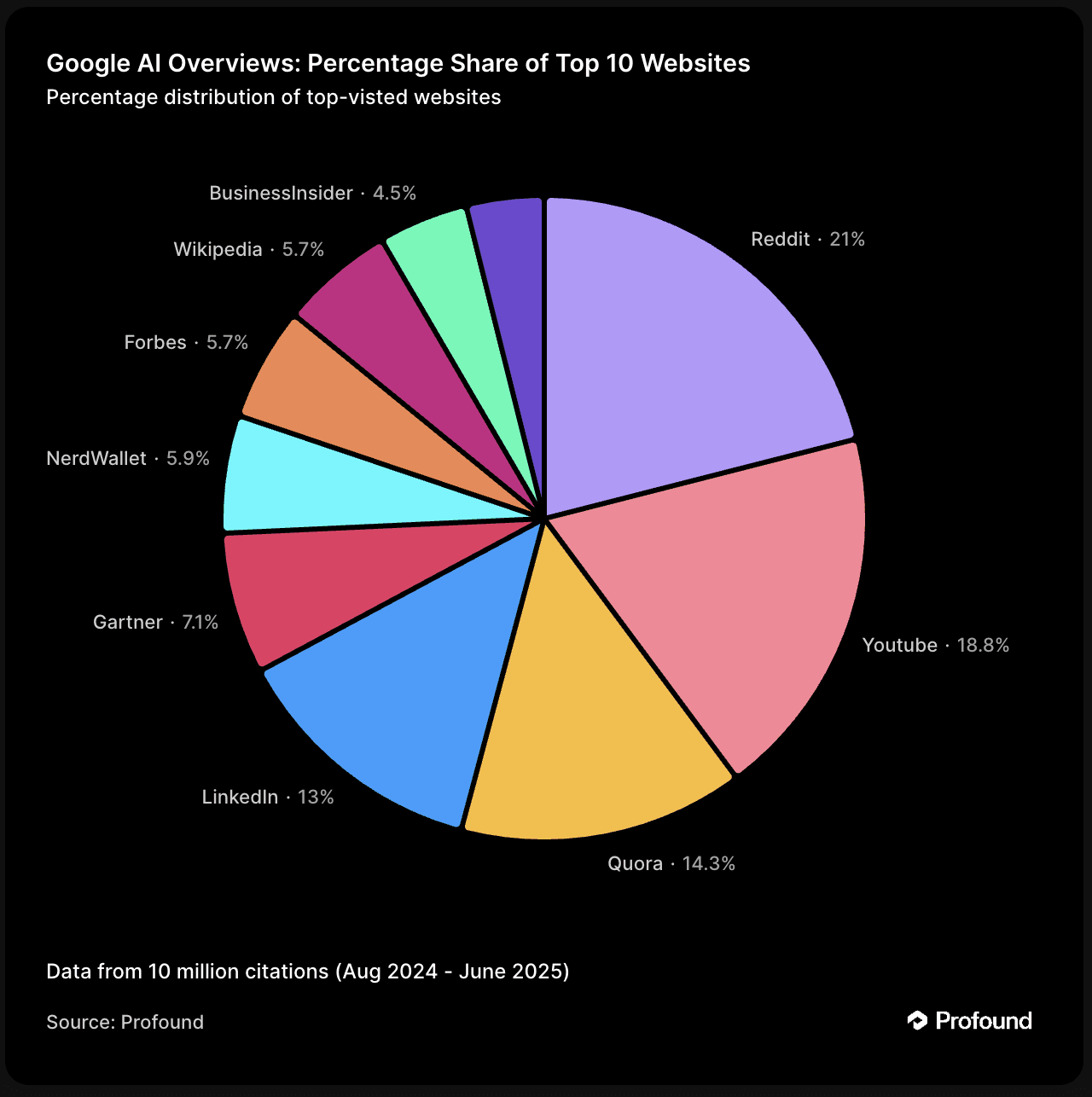Brought to you by Profound, helping brands like Ramp, MongoDB, and Indeed monitor, optimize, and grow revenue from AI search.
Track AI visibility across ChatGPT, Perplexity, and other LLMs, monitor how often AI bots are crawling your site, and create content that LLMs love.
Get 20% off Profound Lite with code GAURAV20 here.
ChatGPT hit 500 million monthly active users in May 2025.
This was the same month that Google announced AI Mode, their version of ChatGPT, directly within Google search:
This is the defining moment. Google is admitting that LLMs are the search interface of the future.
Every brand is noticing the open-mouth “alligator effect” in their SEO metrics:
Impressions are up, and clicks are down. And AI is to thank — or blame, depending on how salty it makes you feel.
I see these patterns at startups I advise: ChatGPT and other LLMs are rapidly rising in “How Did You Hear About Us?”. Some of my clients have an astounding 30% of their weekly traffic from ChatGPT.
Just as important is the speed of change. For example, Vercel saw 10% of their signups come from ChatGPT in April 2025, up from 4.8% in March 2025, and 1% in October 2024.
ChatGPT and LLMs aside, most startups I work with see traditional search (i.e., Google) account for 30-50% of their signups. And as above, Google is shifting towards AI Overview and AI Mode.
So search has decisively shifted towards LLMs. And it affects every online business worldwide.
What should you do about it?
First, we’ll debunk the top two misconceptions surrounding GEO. Then we’ll dive into what to do about GEO.
This post is for anyone responsible for acquisition: founders, growth, and marketers.
Here are the facts:
Google’s AI Overviews appear at the top of over 50% of searches. This is up from 25% just 10 months ago (source).
ChatGPT is already 3% of Google’s traffic. This might surpass 10% by the end of this year, and could match Google within the next 5 years (source).
Google’s AI Mode is currently in beta, but if AI Overviews are any proxy, it will see rapid rollout and adoption.
GEO is already extremely important for any company whose customers find them online.
This is directionally true in that you need content with authority to feature in both traditional and LLM search.
But execution tactics differ.
To understand why, let’s compare traditional search and LLM search.
The average traditional search is 3-5 words.
The average LLM search is extremely detailed and nuanced at 20+ words, not counting follow-ups. In traditional SEO, they would be “long tail searches”.
A traditional search strategy might manufacture content aimed at winning clicks for high-volume but low-signal traffic, like “AI notetaker”.
An LLM search strategy needs to maximize chances of being cited in a long tail search like “List the top 10 AI notetakers and give me their cost, pros, and cons”.
It must do this with rich and authoritative content with facts, benefits, advantages versus competitors, and specific use cases.
Traditional search gives you a pile of blue links to explore.
LLMs provide one answer composed of many different sources, aiming to fully answer your question. You likely will not click through to multiple sites.
LLM traffic that does click through tends to convert extremely well. For example, Ahrefs sees LLMs represent only 0.5% of visitors but over 12% of signups. LLM search converts 12x better than traditional search.
Brands first need to win citations, then optimize websites for high-intent traffic.
Kevin Indig, SEO expert, studied the types of content that rank well in LLMs.
He found that traditional SEO factors like backlinks, keywords, and total traffic were not significantly correlated with LLM citations.
Instead, LLMs pay attention to factors like domain authority, content comprehensiveness, and readability.
While GEO has directional overlap with SEO, the finer nuances of how to win GEO differ:
Hopefully you’re convinced by now that GEO is a priority.
If you’re still unsure, ask:
How fast are your customers adopting AI to search?
Size traditional search. Use Google Keyword Planner, or third-party tools like Ahrefs or SEMRush. Assume half of those searches are influenced by AI Overviews.
Size LLM search. Use Profound’s Conversation Explorer to quantify how often your problem space appears in LLMs. Currently available to Enterprise customers.
Directly survey your customers and ask how frequently they search using LLMs like ChatGPT, Google AI Mode, and Perplexity.
How do customers currently find you?
Ask “How did you hear about us?” (HDYHAU) in your new user journey. This reveals when users might have heard about you in one place, for example ChatGPT, even if your attribution doesn’t track that.
Read more in this Growth by Gaurav essay.
Either of these should be a trigger for you to prioritize GEO:
If >10% of your customers search with AI.
If >5% of your customers already find you via AI.
If you’ve decided GEO is a priority, here is a step-by-step playbook a single person on your team can follow.
Run a full technical GEO and SEO audit.
Learn the rules. For example, see Step 8 in Aleyda Solis’ guide here.
Speed up your site, nail meta tags, and page titles.
Add structured data, kill broken links, and fix duplicate content.
Mixed messaging confuses AI and users.
Clarify what you stand for. Define your core message and tone.
Make every channel reflect it: Website, social, blog, and beyond.
Tell your story the same way everywhere.
Answer questions early to win AI citations.
Learn from sales, support, and search forums what questions customers ask before buying.
Answer them better than anyone else.
Predict emerging questions and answer before others do.
Turn old pages into new growth drivers.
Audit old posts: Update statistics, fix links, and add depth.
Update language to be more precise and descriptive to help AI.
Improve structure, clarity, SEO tags, cross-links.
For an incredibly detailed guide, again refer to Aleyda Solis’ checklist here.
Be the best answer on the internet.
Publish detailed landing pages, competitor comparisons, how-to guides, and answers to top questions.
Include real statistics, unique insights from subject-matter experts, and compelling case studies.
To move fast, repurpose existing media. For example, cut and transcribe existing podcasts and video clips.
Build an AI-friendly footprint across the internet.
Study what websites LLMs cite most often for prompts related to your business.
Profound studied the top domains per LLM from 30M citations. The top 5 sources for ChatGPT and Google AI Overviews were Wikipedia, YouTube, Reddit, Quora, and LinkedIn. Beyond this, high-trust sites like Forbes, G2, and Gartner feature heavily.
Build a web of content that features across these sites. Participate in forums, commission influencer content, publish op-eds, and more.
Search is a compounding game.
Track LLM visibility, share of voice, sentiment, clicks, and HDYHAU.
Fill gaps with frequent new content and technical tune-ups.
Revisit conversion optimization and retargeting strategies to make the most of your MOFU.
Last but not least, want a concrete timeline for your GEO efforts this quarter?
Remember, it’s not whether LLMs will affect your funnel. It’s when.
Forward this to a founder, growth person, or marketer.
Until next time.
For more:
The Great Decoupling (or Why Your Clicks Are Down and Impressions Up) — Ryan Law, Ahrefs
What content works well in LLMs? — Kevin Indig, Growth Memo
AI Search Content Optimization Checklist — Aleyda Solis, SEOFOMO
AI Platform Citation Patterns: How ChatGPT, Google AI Overviews, and Perplexity Source Information — Nick Lafferty, Profound
Homepage Traffic is Up 10.7% from AI Overviews and LLMs [50-Site Study] — Ross Hudgens, Siege Media
Are AI Chatbots Replacing Search Engines? A 2-Year Data Study on Web Traffic — Sujan Sarkar, One Little Web
7 Steps to Reclaim Your Traffic with an Informed AI SEO Strategy — Will Melton, Xponent21
Google’s AI Overviews Surpass 50% of Queries, Doubling Since August 2024 — Will Melton, Xponent21
.png)








![Rockstar fired developers looks like "union busting" [video]](https://www.youtube.com/img/desktop/supported_browsers/edgium.png)
